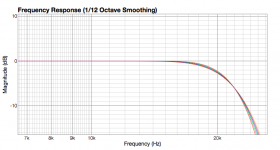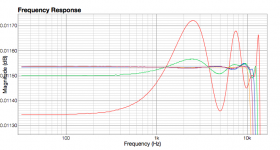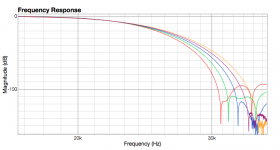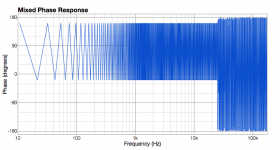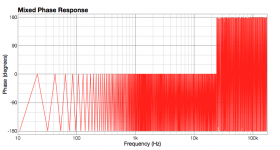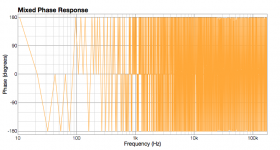Paul, I think I prefer C128x100 instead of C128x90. It seems at least to my ears that instruments are more full bodied. But is it possible to provide a C128x80 version to check again? Thank you Panagiotis
It is interesting you should say that
I've attached C128_80v8.
There is only minor variation in the response. Roll-off seems to begin around 15kHz, and there is a spread of less than 0.5dB at 20kHz where the filters are between 2.5dB and 3dB down.
What is noticeable with smoothing set to none, and much higher zoom levels is the effect of reducing sidelobe attenuation. 128-80:red, 128-90: green, 128-100: blue, 128-110: purple, 128-120: orange
The 80 and to a lesser degree the 90 show obvious ripple, although even with the 80 this looks to be about 0.00037dB peak to peak, so this well beneath the +/-0.001dB threshold for audible colouration mentioned in Gerzon's article on equalisers.
Roll off and stop band show the trade offs between the two - the 80 rolls off earlier but has the worst stop band performance.
tbc
Attachments
To continue...
This shows the roll-off to 0.1dB of the 4 filters 80, 90, 100, 110.

I've had to adjust the 0dB point on a couple of them but ran out of adjust resolution so there are minor differences in 0dB.
You can clearly see the effect of reducing the sideline attenuation with the 110 rolling off lowest and the 80 highest. It looks to me that there is about a 1kHz spread between 80 and 110.
To put things into context lets check the NOS response vs C128_100.

The NOS filter is down 0.01dB at 1.1kHz 0.1dB at 3.9kHz and 0.7dB at 10kHz.
I believe the "better bass" that the NOS filter displays is largely due to the gentle roll-off through the mid range and upper frequencies. The effect seems to be to tilt the tonal balance to favour the bottom end.
With the C128 filters the changes are largely in the roll-off point and amount of stop-band attenuation, but I believe the roll-off point is the main distinguishing factor. So even the relatively small differences in response between C128_90 and C128_110 is sufficient to make a difference in the amount of "air" and perceived weight of the bass in recordings.
This shows the roll-off to 0.1dB of the 4 filters 80, 90, 100, 110.
I've had to adjust the 0dB point on a couple of them but ran out of adjust resolution so there are minor differences in 0dB.
You can clearly see the effect of reducing the sideline attenuation with the 110 rolling off lowest and the 80 highest. It looks to me that there is about a 1kHz spread between 80 and 110.
To put things into context lets check the NOS response vs C128_100.
The NOS filter is down 0.01dB at 1.1kHz 0.1dB at 3.9kHz and 0.7dB at 10kHz.
I believe the "better bass" that the NOS filter displays is largely due to the gentle roll-off through the mid range and upper frequencies. The effect seems to be to tilt the tonal balance to favour the bottom end.
With the C128 filters the changes are largely in the roll-off point and amount of stop-band attenuation, but I believe the roll-off point is the main distinguishing factor. So even the relatively small differences in response between C128_90 and C128_110 is sufficient to make a difference in the amount of "air" and perceived weight of the bass in recordings.
Test Tracks
Just for the record I'd thought I'd list my reference tracks. I don't usually mention them specifically because it's about as exciting as listening to them over and over
Morelenbaum2/Sakamoto: Bonita from the cd Casa released on Sony Classical. The track starts with field recording of wave breaking gently on Ipanema Beach, before settling in to cello, piano and vocals.
Bliss: Right Here from Quiet Letters Vocals and piano. And would you believe, a Danish group?
Miles Davis" So What from Kind of Blue Especially the piano/bass intro, the entry of percussion and attack of drum hits, tonality of turmpet during the first couple minutes.
Aes Dana: Leylines from Leylines Weight of synth pads cf to other elements. Definition of baselines and kick drums, "height" of swirling vocal samples. But basically a track I enjoy listening to: https://www.youtube.com/watch?v=D5OFTGeS7nA
David Sylvian: Before the Bullfight, River man from "Gone to Earth". Awesome recording, checking for drum/bass impact amongst other things. This recording is good enough reference material that "River Man" was one of three tracks mentioned in the 2009 HNRR's review of the Wadia 318i, along side Dianne Krall and Leonard Cohen.
LEDR - check positioning accuracy and height of "Over" and "Up".
Less used
Herbie Hancock Raindance from Sextant Definition of handclaps through the intro, recovery of the studio ambience, but generally just a great track to listen too.
Jaia: Alone from Fahrenheit Project 5
ABC Tears are Never Enough from Lexicon of Love. A difficult recording//bad mastering from first CD release. It can sound good if handled with care as with Izotope SRC - so shouldn't sound unlistenable with a good filter.
Just for the record I'd thought I'd list my reference tracks. I don't usually mention them specifically because it's about as exciting as listening to them over and over
Morelenbaum2/Sakamoto: Bonita from the cd Casa released on Sony Classical. The track starts with field recording of wave breaking gently on Ipanema Beach, before settling in to cello, piano and vocals.
Bliss: Right Here from Quiet Letters Vocals and piano. And would you believe, a Danish group?
Miles Davis" So What from Kind of Blue Especially the piano/bass intro, the entry of percussion and attack of drum hits, tonality of turmpet during the first couple minutes.
Aes Dana: Leylines from Leylines Weight of synth pads cf to other elements. Definition of baselines and kick drums, "height" of swirling vocal samples. But basically a track I enjoy listening to: https://www.youtube.com/watch?v=D5OFTGeS7nA
David Sylvian: Before the Bullfight, River man from "Gone to Earth". Awesome recording, checking for drum/bass impact amongst other things. This recording is good enough reference material that "River Man" was one of three tracks mentioned in the 2009 HNRR's review of the Wadia 318i, along side Dianne Krall and Leonard Cohen.
http://www.hifinews.co.uk/news/article/wadia-381i-cd-player-pound;8000/9131David Sylvian's brooding 'River Man' from Gone To Earth [Virgin] was delivered with menacing power and tension, Robert Fripp's delicately droning electric guitar treatments sounding more ominous than ever. The sonic picture was gloriously open and spacious, the subterranean bass lines once again sounding powerful and assured.
LEDR - check positioning accuracy and height of "Over" and "Up".
Less used
Herbie Hancock Raindance from Sextant Definition of handclaps through the intro, recovery of the studio ambience, but generally just a great track to listen too.
Jaia: Alone from Fahrenheit Project 5
ABC Tears are Never Enough from Lexicon of Love. A difficult recording//bad mastering from first CD release. It can sound good if handled with care as with Izotope SRC - so shouldn't sound unlistenable with a good filter.
Last edited:
Paul,
my response surely was not directed at you...
It's taken the me best part of three days to even notice the post you were responding to.
Last edited:
looking for the perfect beat...
I like the bottom end of the C128-100 and the air of the C128-90, so I figure there has to be a setting in between that is has a nice blend of tops and bottom end.
As a starting point I've done a C128_95 to split the difference, and to my ears, and on my system, it sounds like it's pretty well balanced.
Obviously I can only account for my tastes and system in listening tests so as always YMMV.
I like the bottom end of the C128-100 and the air of the C128-90, so I figure there has to be a setting in between that is has a nice blend of tops and bottom end.
As a starting point I've done a C128_95 to split the difference, and to my ears, and on my system, it sounds like it's pretty well balanced.
Obviously I can only account for my tastes and system in listening tests so as always YMMV.
Attachments
Ok I'm going to take another tack on this.
The C128_95/100/110 seem to be around the sweet spot for the this type of approach to the Nyquist filters. They are smooth, and nice to listen to but in comparison with something like the Izotope SRC they lack a bit of sparkle and punch.
So this an outlier test filter and is probably about as brick wall as the Nyquist filters can get.
I've uploaded to versions one with beta = 20, and a second with beta = 12.25 which is roughly the setting SoX uses by default.
And the test track of the day...
https://www.youtube.com/watch?v=4i3Acuoshgc
The C128_95/100/110 seem to be around the sweet spot for the this type of approach to the Nyquist filters. They are smooth, and nice to listen to but in comparison with something like the Izotope SRC they lack a bit of sparkle and punch.
So this an outlier test filter and is probably about as brick wall as the Nyquist filters can get.
I've uploaded to versions one with beta = 20, and a second with beta = 12.25 which is roughly the setting SoX uses by default.
And the test track of the day...
https://www.youtube.com/watch?v=4i3Acuoshgc
Attachments
Last edited:
Should have added the above filters are -0.1dB at slightly over 21kHz and are fully attenuated at 23.5kHz for the K960_1225 and 24kHz for the K960_20.
These are far less coloured than the C128 series.
As an added bonus I've done a C960_140 version, which uses the Chebyshev window and 140dB side lobe attenuation, and is fully attenuated by 24kHz.
At the moment I'm slightly favouring the C960_140 out of the steep NQ filters.
These are far less coloured than the C128 series.
As an added bonus I've done a C960_140 version, which uses the Chebyshev window and 140dB side lobe attenuation, and is fully attenuated by 24kHz.
At the moment I'm slightly favouring the C960_140 out of the steep NQ filters.
Attachments
Should have added the above filters are -0.1dB at slightly over 21kHz and are fully attenuated at 23.5kHz for the K960_1225 and 24kHz for the K960_20.
These are far less coloured than the C128 series.
As an added bonus I've done a C960_140 version, which uses the Chebyshev window and 140dB side lobe attenuation, and is fully attenuated by 24kHz.
At the moment I'm slightly favouring the C960_140 out of the steep NQ filters.
Hi Paul. Just tried the C960_140. It feels much more airy and sparkled than the C128_100 that I was using, with all the nice characteristics of it. Only drawback that I noticed is that "shhh"s are now much more pronounced and distorting.
Hi Paul. Just tried the C960_140. It feels much more airy and sparkled than the C128_100 that I was using, with all the nice characteristics of it. Only drawback that I noticed is that "shhh"s are now much more pronounced and distorting.
I concur with the filter being more sibilant... but everything else is much better than the c128 filters for me.
Hi Paul. Just tried the C960_140. It feels much more airy and sparkled than the C128_100 that I was using, with all the nice characteristics of it. Only drawback that I noticed is that "shhh"s are now much more pronounced and distorting.
They shouldn't be distorting due the filter. The maximum level in the filter is exactly the same as in the other NQ filters.
The filters are dead flat up to 21kHz. Within +/-0.000002dB.
I know the tracks that sound sibilant on the DAM in my system are sibilant in the recording - it can be seen in a spectrogram of the recording and isolated. It is apparent on 5-6 recordings.
A brief listen revealed me that the C128-100 is more coherent sounding than C960-140.
Also bass to mid-range resolution felt better with C128. Tonal balance feels more right as well. The C960 felt snappier andairier though but neither are sibilant in my system.
I have fairly stock build and signal goes from ladder directly to Genelec monitors, which are pretty neutral and revealing.
Ears are tired for today, will listen more carefully tomorrow.
Also bass to mid-range resolution felt better with C128. Tonal balance feels more right as well. The C960 felt snappier andairier though but neither are sibilant in my system.
I have fairly stock build and signal goes from ladder directly to Genelec monitors, which are pretty neutral and revealing.
Ears are tired for today, will listen more carefully tomorrow.
A brief listen revealed me that the C128-100 is more coherent sounding than C960-140.
Also bass to mid-range resolution felt better with C128. Tonal balance feels more right as well. The C960 felt snappier andairier though but neither are sibilant in my system.
I have fairly stock build and signal goes from ladder directly to Genelec monitors, which are pretty neutral and revealing.
Ears are tired for today, will listen more carefully tomorrow.
The better bass and mid range in the C128-100 etc is largely perceptual. It's primarily due to these filters starting to roll off 5-6kHz lower than the C960.
I thought I'd detected what I thought might be a oscillation of some kind in a small frequency band between about 10-12kHz when I was checking evenness of response with sine sweeps last weekend.
I've spent about 45 minutes listening to 1-12.5kHz sine sweeps, and it sounds like there is a bit of what I can only describe as a modulation at higher frequencies that might be giving the impression of distortion. It's possible a phase issue - not sure.
With the Izotope SRC and ClassicBW the sine is a stable tone until close much the top of the sweep, and stable below. The long NQ filters have a weird almost fluttering quality like the tone is being modulated from far lower in the sweep.
It's a bit ordinary listening to sweeps, so not sure how much more I can say for the moment.
I'd done a C576_140 yesterday and that seems more stable and the sibilance is same or lower than the same track upsampled to 352.8kHz using Audirvana+ Izoptope SRC at defaults. I feel the overall balance is closer to the Izotope upsampling than other variants. Using Izotope as a reference the C128_100 is nice but a bit soft in the top end.
There are two versions, one is like the other nyquist filters with the 0's at 8 sample spacing. The second is a "nz" version where the parameters are changed slightly so the zeros are not generated. This was mainly a test to see if the zero pattern in the filter was causing issues. It mainly results in a loss of transparency as far as I can tell.
With the Izotope SRC and ClassicBW the sine is a stable tone until close much the top of the sweep, and stable below. The long NQ filters have a weird almost fluttering quality like the tone is being modulated from far lower in the sweep.
It's a bit ordinary listening to sweeps, so not sure how much more I can say for the moment.
I'd done a C576_140 yesterday and that seems more stable and the sibilance is same or lower than the same track upsampled to 352.8kHz using Audirvana+ Izoptope SRC at defaults. I feel the overall balance is closer to the Izotope upsampling than other variants. Using Izotope as a reference the C128_100 is nice but a bit soft in the top end.
There are two versions, one is like the other nyquist filters with the 0's at 8 sample spacing. The second is a "nz" version where the parameters are changed slightly so the zeros are not generated. This was mainly a test to see if the zero pattern in the filter was causing issues. It mainly results in a loss of transparency as far as I can tell.
Attachments
Last edited:
Looking at the mixed phase in fuzzmeasure it seem the filters that have the hf modulation on sine sweeps have phase that swings from 180 through zero to -180 degrees, so 360 degrees. The C128, C576 and K960 have a phase swing of half that, slightly offset. The exception is Izotope which at the default A+ setting also has the 180 -> -180 phase swing.
NOS has a 180 degree swing, but it is non-linear in the audio band so moves from +180 to 0 below 1kHz, and then slowly shifts to -180 to 0 by Fs.
Not 100% sure if the full 180 to -180 phase swing is the cause of this effect, or why Izotope doesn't seem afflicted in the same way.
NOS has a 180 degree swing, but it is non-linear in the audio band so moves from +180 to 0 below 1kHz, and then slowly shifts to -180 to 0 by Fs.
Not 100% sure if the full 180 to -180 phase swing is the cause of this effect, or why Izotope doesn't seem afflicted in the same way.
Last edited:
Comparing to BADA, DAM sounds a bit rougher and strained regardless of the used filter. Some filters sound better some are worse (I prefer sharp roll off, flat beyond 20kHz; eg. C960 sounds fine or one of my trials in attachment). I tried to spot the difference measurements wise; and the most obvious thing is distortion harmonic spectrum which for the bada is clean beyond H3 where for DAM odd harmonics are slowly rising with most of them being higher than H3 (same thing on buffered and unbuffered output).
I'm using AC power supply, and mostly listen unbuffered output with sowter transformers, but I think buffered sounds quite good too.
I'm using AC power supply, and mostly listen unbuffered output with sowter transformers, but I think buffered sounds quite good too.
Attachments
Looking at the mixed phase in fuzzmeasure it seem the filters that have the hf modulation on sine sweeps have phase that swings from 180 through zero to -180 degrees, so 360 degrees. The C128, C576 and K960 have a phase swing of half that, slightly offset. The exception is Izotope which at the default A+ setting also has the 180 -> -180 phase swing.
NOS has a 180 degree swing, but it is non-linear in the audio band so moves from +180 to 0 below 1kHz, and then slowly shifts to -180 to 0 by Fs.
Not 100% sure if the full 180 to -180 phase swing is the cause of this effect, or why Izotope doesn't seem afflicted in the same way.
Could you make one or two pictures to illustrate. I do not exactely see what you mean with the phase swings.
Could you make one or two pictures to illustrate. I do not exactely see what you mean with the phase swings.
Oki
This is wrapped phase from three filters showing what I mean.
Attachments
Comparing to BADA, DAM sounds a bit rougher and strained regardless of the used filter.
The filters aren't going to do very much reduce to the harmonics of the test tone, as the harmonics seem to be primarily related to the R2R architecture. Balanced output will attenuate the even harmonics but that is about it. The filters do effect the amount of "junk" between the harmonics quite substantially however.
Which version of the Alpha are we talking about? Alpha, Alpha 2?
Both the Alpha and Alpha 2 were regarded by reviewers as amongst the best DAC's available both at their price point ($5000US) and outright.
Last edited:
- Home
- Source & Line
- Digital Line Level
- Filter brewing for the Soekris R2R
